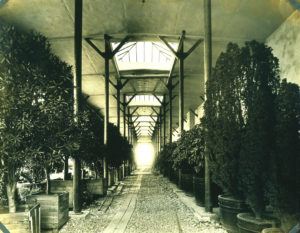A new Rockefeller center in Pocantico Hills

For David Rockefeller Sr., the art of business was inextricably linked to the business of art, as it has been for other members of his legendary family.
“If we think of David Rockefeller as the exemplar, he felt art was important to business,” says Stephen Heintz, president and CEO of the Rockefeller Brothers Fund. “He saw creativity as useful in business.”
So it”™s not surprising that a new creative arts center on the Pocantico Hills compound of the family”™s former home should be named for the late patriarch (1915-2017) ”“ the youngest child of John D. Rockefeller Jr. and youngest grandchild of John D. Sr. ”“ or that family and friends should be among those contributing $26 million for its establishment, along with the Fund and friends of The Pocantico Center.

Opening Oct. 1, The David Rockefeller Creative Arts Center will offer free exhibits and low-cost performances, lectures and workshops as well as artists”™ residencies and opportunities for local cultural groups in an 8,000-square-foot space that represents the refurbishment and expansion of the family”™s former Orangerie, a 1908 Beaux Arts structure that was modeled after the orangery in Versailles. The new center is the latest jewel in the crown that is The Pocantico Center of the Rockefeller Brothers Fund, consisting of Kykuit, the Beaux Arts-style 1913 Rockefeller family home, which former Vice President and New York Gov. Nelson A. Rockefeller left to the National Trust for Historic Preservation; the Abeyton Lodge; the Marcel Breuer House; the Coach Barn; and several guest houses ”“ all perched amid gardens and undulating verdure high above the Hudson River, 20 miles north of Manhattan. While The Pocantico Center is owned by the National Trust, it is managed by the Fund, a philanthropic foundation established in 1940 by John D. Jr.”™s five sons ”“ John D. III, Nelson, Laurence, Winthrop and David. (They were later joined by their only sister, Abby Rockefeller Mauzé.) As the kid brother and just 25 at the time, David served as secretary. “They made him take the minutes,” Heintz says with a laugh.
On a hot, humid day, he has teamed with Judy Clark, executive director of The Pocantico Center, to offer the Westchester County Business Journal a sneak peek at what may be one of the most exciting arts spaces to open in Westchester County in years. Working with FXCollaborative, the Brooklyn-based architectural firm, and Yorke Construction of Manhattan, the Fund has reimagined the Orangerie while preserving much of the neoclassical brick, steel, glass and concrete building, in accordance with the National Trust, Heintz says. So the shape of the soaring, arched Palladian windows remains, but they have been replaced by double-glazed glass, as the entire building is designed to yield net-zero emissions.
On the far left as you enter the lucent, white space is the quiet artists”™ studio, which contains a galley, adjustable track lighting, glass doors, an air filtration system and a side entrance so that the artist in residence can slip in any time of the day or night to work during the two-month period. The first artist in residence and winner of the $25,000 Pocantico Prize will be Peekskill”™s Athena LaTocha, whose massive, textured, earth-toned mixed-media works on paper consider the relationship of nature and humanity, reflecting the Alaska native”™s indigenous heritage (Lakota and Ojibwe) as well as the Rockefeller Brothers Fund”™s interest in multiculturalism and the environment. (On campus LaTocha will be staying at the three-bedroom Marcel Breuer House, created by the Modern architect, who lived in New Canaan.)
The Fund is also offering for the first time an annual grant that will enable local arts groups working with the underserved to use the 900-square-foot studio for up to six months. The first awardee is Arts10566 Inc., which provides a diverse group of youths in Peekskill and its environs with free access to the arts.
From the DR Center”™s studio, you step into a gallery whose first exhibit will be “Inspired Encounters: Women Artists and the Legacies of Modern Art” (Oct. 1 through March 19), in which contemporary artists consider works by female Modernists, drawn mainly from the Kykuit collection, which was curated by Nelson himself. (It”™s a reminder that his mother, Abby Aldrich Rockefeller, was key to the founding of The Museum of Modern Art in Manhattan.)
Next to the studio is the reception area, which will have orange

trees, and a performance space with a sprung wood floor for dance, retractable telescopic seating for 200 and doors that open onto a terrace, a solar panel array and a rain garden to conserve water and reduce runoff pollutants. This space, which will double the number of performances that have been held on the campus since 2012 to eight, required a dramatic renovation with the removal of three pairs of weight-bearing columns and the placement of steel cables overhead to shift support for the roof to the outer walls.
The DR Center includes an addition that contains storage space, a cloakroom and a feature that is sure to be the talk of the town ”“ a gender-neutral bathroom, whose stalls include doors to the floor for maximum privacy. It”™s a first for the town of Mount Pleasant, Heintz says, adding that after a recent tour, the Rockefeller Brothers”™ Fund board is getting on board with the idea.
It”™s just another example of a state-of-the-art, forward-looking space that typifies a family that has always sought to be on the vanguard of business, politics, ecology, philanthropy and the arts.
“The Rockefeller properties in Westchester embody the family”™s interests in the environment, historic preservation, farming and agriculture, and international engagement,” Rockefeller Brothers trustee David Jr. says in a statement. “A space for arts and culture is the final important piece to complete this extraordinary mosaic. My hope is that The David Rockefeller Creative Arts Center will inspire and nourish a new generation”¦.”
For more, visit here.